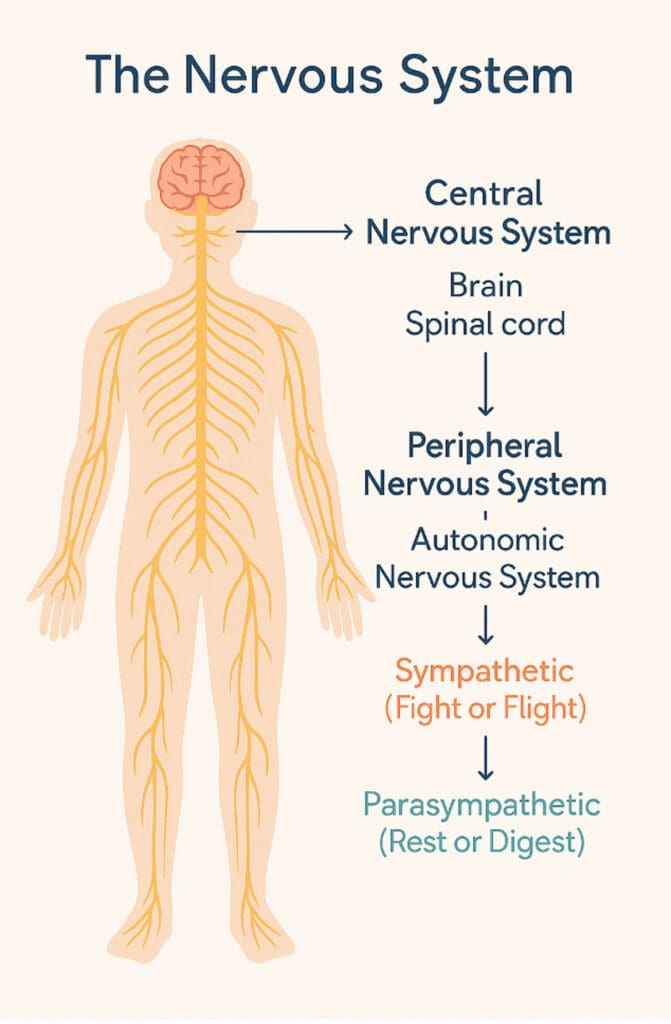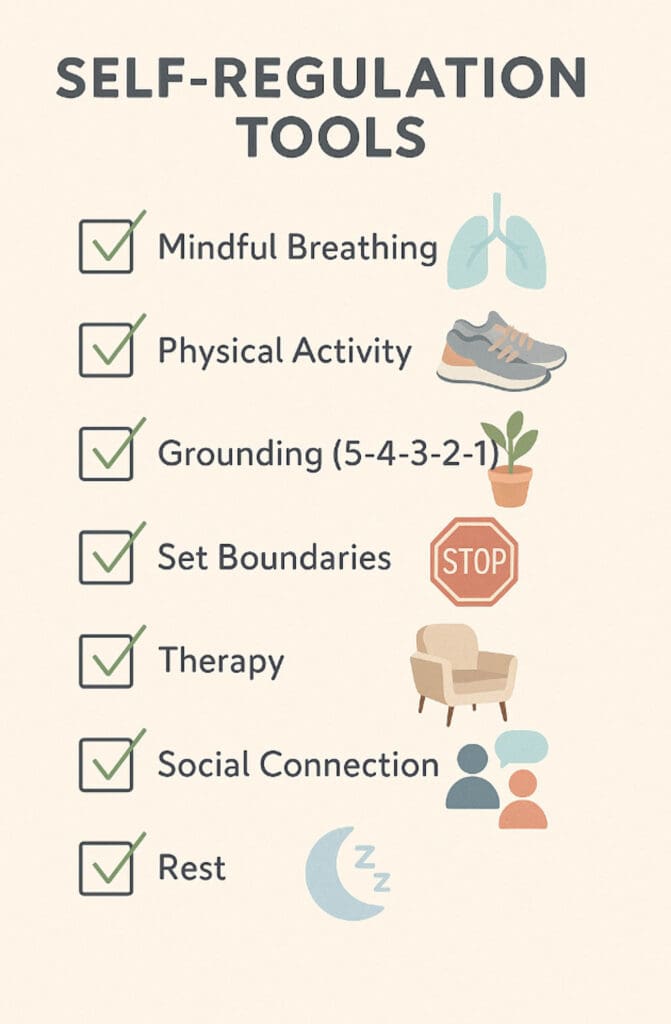
Imagine you have an important task to do, but you just can’t get yourself to do it.
Your mind is racing, you feel inexplicably on edge, and somehow you’ve started scrolling on your phone instead.
Hours pass, and you’re still procrastinating…
Until panic about the deadline finally kicks in. Sound familiar?
You’re not lazy or lacking willpower, your nervous system might be behind the wheel.
Let’s explore how this intricate system influences your drive and consistency, and more importantly, how you can regain control (no heavy jargon, just real talk).
Understanding Your Nervous System
Think of your nervous system as your body’s command center, orchestrating everything from your heartbeat to your reactions to stress. It’s divided into two main parts:
- Central Nervous System (CNS): This includes your brain and spinal cord, acting as the main processing hub.
- Peripheral Nervous System (PNS): This network extends from the CNS to the rest of your body, relaying information back and forth.
Within the PNS lies the Autonomic Nervous System (ANS), which operates behind the scenes, managing functions like digestion, heart rate, and breathing. The ANS has two primary branches:
- Sympathetic Nervous System: Activates the “fight or flight” response during perceived threats.
- Parasympathetic Nervous System: Promotes “rest and digest” activities, calming the body after stress.
In an ideal scenario, these systems work in harmony, allowing you to respond to challenges and then return to a state of calm. However, life isn’t always ideal, and prolonged stress or trauma can disrupt this balance.

The Impact of Trauma and Burnout on Your Nervous System
Life throws curveballs, some minor, some that hit hard.
Experiences like losing a loved one, enduring a toxic work environment, or facing ongoing financial stress can leave lasting imprints on your nervous system.
Trauma, whether a single harrowing event or prolonged exposure to stress, can push your nervous system into overdrive.
Imagine your body’s alarm system getting stuck in the ‘on’ position, leaving you perpetually anxious, restless, or on edge.
This isn’t just in your head; it’s your body’s way of saying, “I’m still processing that.”
And trauma isn’t limited to extreme events. Research on Adverse Childhood Experiences (ACEs) shows that even prolonged chronic stress in childhood – such as living with neglect, constant criticism, or instability – can wire your nervous system for dysregulation later in life. [1]
On the flip side, burnout, the kind that comes from chronic workplace pressure, caregiving, or simply too much on your plate for too long, has a similar effect on the nervous system.
Think of burnout as your body’s way of saying “Enough!” If you’ve ever pushed and pushed through stress and then found yourself suddenly exhausted or ill, that’s burnout in action.
The stress response that kept you going finally crashes.
Emily and Amelia Nagoski, sisters and authors of Burnout, put it this way: “the stress itself will kill you faster than the stressor will, unless you do something to complete the stress response cycle” [2]
Regulated vs. Dysregulated Nervous Systems
A regulated nervous system allows you to handle stress effectively, recover from challenges, and stay connected to your emotions and goals.
In contrast, a dysregulated nervous system can leave you stuck in patterns of overwhelm, shutdown, or constant anxiety, often without you even realizing it.
According to Stephen Porges’ Polyvagal Theory, the state of your nervous system is shaped by how your body perceives safety or threat. Trauma or prolonged stress can disrupt this balance, pushing your nervous system into dysregulation.
Here’s how it works:
- Regulated Nervous System (Ventral Vagal State):
When your nervous system is regulated, you feel calm, safe, and connected. This state supports emotional balance, focus, and resilience. You’re able to respond to stress in a healthy way and return to a baseline of calm afterward. - Dysregulated Nervous System:
- Hyperarousal (Sympathetic State): When stuck in fight-or-flight mode, you may feel anxious, restless, or panicked, unable to relax or focus. This state often arises after prolonged stress or unresolved trauma.
- Hypoarousal (Dorsal Vagal State): On the other hand, if your system shuts down to cope with perceived danger, you might feel numb, detached, or unmotivated. This is your body’s way of conserving energy when it feels overwhelmed.
Sometimes people alternate between the two. Even a minor inconvenience can send you into panic mode or shutdown mode. [3]
Importantly, these responses are usually involuntary. You’re not “choosing” to overreact or freeze up. Your nervous system is flooding you with automatic fight/flight or shut-down reactions.
How This Affects Motivation, Consistency, and Results
So why does all this matter for your day-to-day life?
Because your internal state can make or break your follow-through. When your nervous system is in fight-or-flight overdrive or stuck in freeze, it directly impairs your motivation, focus, and consistency.
For example, studies have found that a dysregulated nervous system weakens your impulse control, making you more prone to procrastination, addictive distractions, and even running yourself into burnout. [1]
This inconsistency can lead to a cycle of self-blame and decreased self-esteem, further exacerbating the problem.
Understanding that these patterns are rooted in your body’s physiological responses can be liberating and pave the way for change.
Tips to Self-Regulate Your Nervous System
Self-regulation means teaching your body to come out of survival mode and return to a calm, flexible state. Here are some effective strategies to help you achieve this balance:
1. Mindful Breathing
Engaging in deep, controlled breathing can activate your parasympathetic nervous system, promoting relaxation and countering stress responses. Techniques like the physiological sigh, which involves two short inhales followed by a long exhale, can be particularly effective in reducing stress.[4]
2. Physical Activity
One of the fastest ways to reset a stressed nervous system is through movement. Regular exercise, such as yoga, walking, or dancing, helps release endorphins, the body’s natural mood enhancers. Physical movement not only improves mood and reduces anxiety but also supports nervous system regulation by promoting relaxation and reducing stress hormones.
3. Grounding Techniques
Grounding exercises anchor you in the present moment, diverting attention from distressing thoughts. The 5-4-3-2-1 technique, for instance, involves identifying five things you can see, four you can touch, three you can hear, two you can smell, and one you can taste. This method engages your senses, helping to calm the nervous system.
4. Setting Boundaries
Establishing clear personal and professional boundaries prevents overcommitment and reduces stress. By communicating your limits, you can manage anxiety more effectively and maintain a balanced nervous system.
5. Seeking Professional Support
Therapies like Eye Movement Desensitization and Reprocessing (EMDR) and Somatic Experiencing (SE) are designed to help process unresolved trauma, facilitating nervous system regulation. These approaches focus on body awareness and reprocessing traumatic memories to restore balance.
6. Safe Social Connection
Engaging in positive social interactions stimulates the ventral vagus nerve, promoting feelings of safety and calm. According to the Polyvagal Theory, social engagement plays a crucial role in regulating the nervous system and fostering relaxation.
7. Prioritizing Rest
Adequate sleep is vital for nervous system health. Quality rest supports memory consolidation, regulates metabolism, and reduces mental fatigue. Ensuring you get sufficient sleep allows your body to repair and maintain optimal nervous system function.
Incorporating these strategies into your daily routine can significantly enhance your ability to self-regulate, leading to improved emotional resilience and overall well-being.

Moving Forward
Understanding the link between your nervous system and behaviors like procrastination or burnout is empowering. It shifts the narrative from self-blame to self-awareness.
By implementing self-regulation techniques, you’re not just addressing surface-level habits but diving deep into the root causes.
Remember, change doesn’t happen overnight. Be patient with yourself and celebrate small victories along the way.
If you’re ready to explore this journey further and seek personalized guidance, consider signing up for the Change Catalyst Clarity Call. Together, we can chart a path toward balance, motivation, and lasting results.
References
- Fleurish Collective. (2025, March 7). Nervous system regulation: What it is & why you should care. Fleurish Collective. https://www.fleurishcollective.com/nervous-system-regulation/
- Brown, B. (Host). (2020, October 14). Brené with Emily and Amelia Nagoski on burnout and how to complete the stress cycle [Audio podcast episode]. In Unlocking Us with Brené Brown. Cadence13. https://brenebrown.com/podcast/brene-with-emily-and-amelia-nagoski-on-burnout-and-how-to-complete-the-stress-cycle
- Porges, S. W. (2011). The polyvagal theory: Neurophysiological foundations of emotions, attachment, communication, and self-regulation. W. W. Norton & Company.
- McMaster Continuing Education. (2024, April 11). Mastering the art of self-regulation: 5 tips to soothe your nervous system. McMaster Continuing Education. https://continuing.mcmaster.ca/mastering-the-art-of-self-regulation-5-tips-to-soothe-your-nervous-system/
- Berceli, D. (2012). Trauma Releasing Exercises (TRE): A Revolutionary New Method for Stress/Trauma Recovery. Books on Demand.
- Kabat-Zinn, J. (1994). Wherever You Go, There You Are: Mindfulness Meditation in Everyday Life. Hyperion.
- Levine, P. A. (1997). Waking the Tiger: Healing Trauma. North Atlantic Books.
- Nagoski, E., & Nagoski, A. (2020). Burnout: The Secret to Unlocking the Stress Cycle. Ballantine Books.
- Schwartz, R. C. (1995). Internal Family Systems Therapy. Guilford Press.
- Van der Kolk, B. A. (2015). The Body Keeps the Score: Brain, Mind, and Body in the Healing of Trauma. Penguin Books.